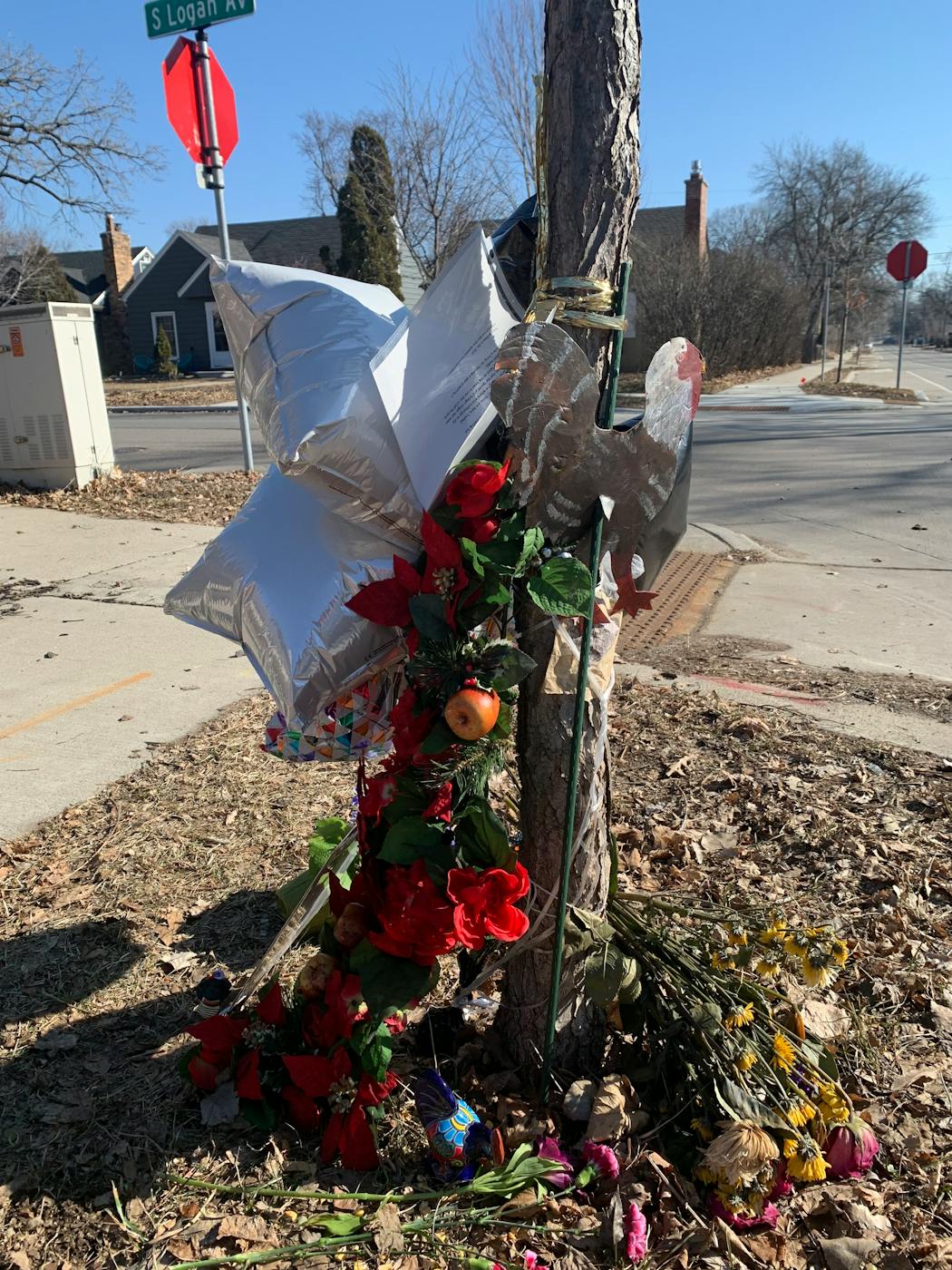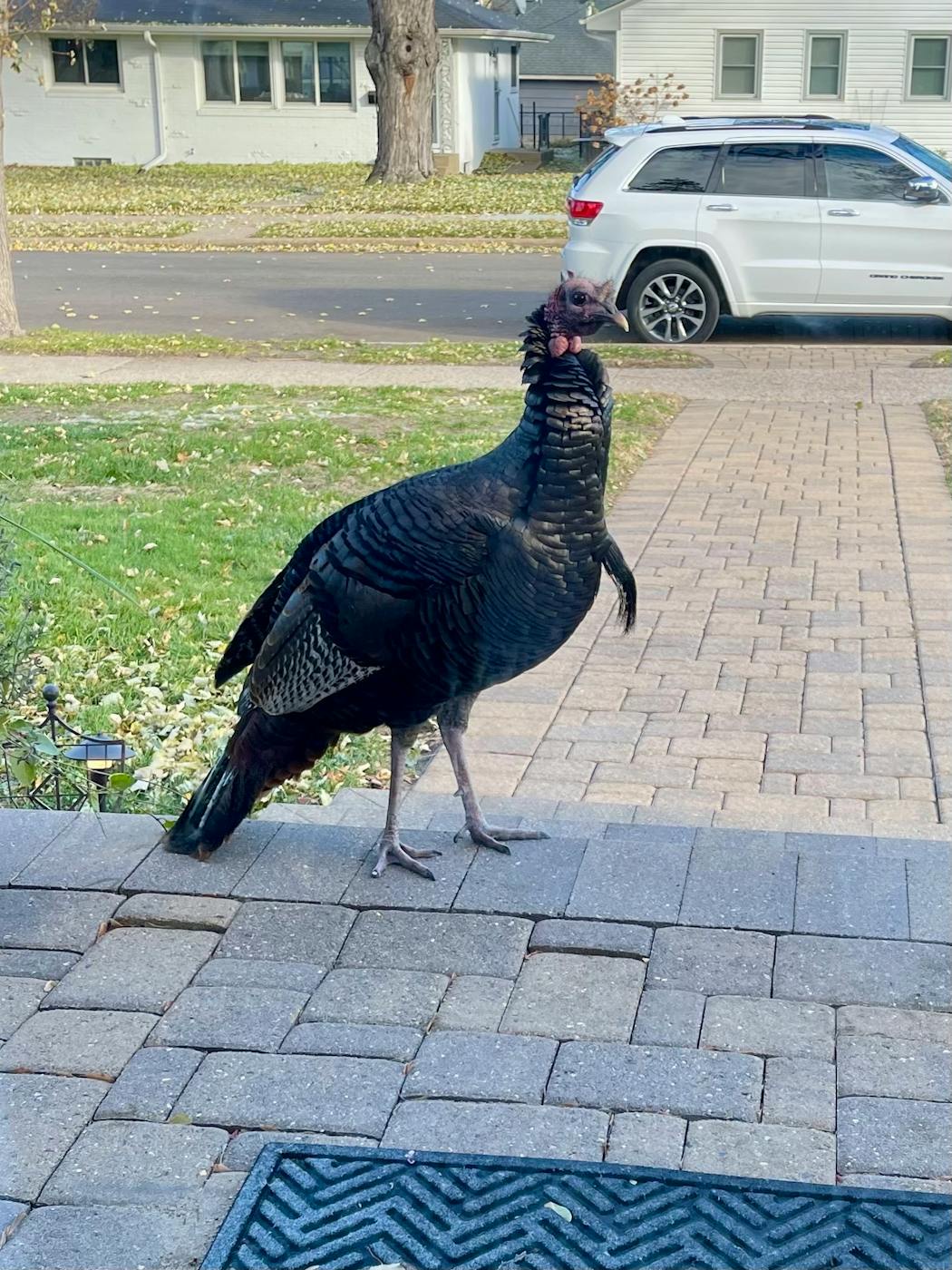It's not uncommon to see a cluster of balloons and flowers commemorating a lost life. But a memorial that recently cropped up in south Minneapolis is something new. There are turkey figurines, a turkey painting and turkey photographs, along with an original four-stanza poem paying homage to the neighborhood mascot, recently found dead in the street.
A neighbor passing the memorial at 54th Street and Logan Avenue chatted up a family taking pictures. "We loved him," she said of the wild bird, recounting how he'd saunter through the intersection, forcing cars to stop, unmoved by their honks.
Neighbors who delighted in turkey sightings over the past year or so had named him: "Gregory Peck," "Tom," "James," (presumably for the avenue where he roamed), "the Bachelor Turkey" (he was always alone). They called him a "community fixture" a "neighbor," even "part of our family." Following online announcements of the bird's death, tributes poured in, including turkey video footage set to Sarah McLachlan's "Angel."
But among the kind words and cute emojis ("Will live forever in our hearts ❤️🦃"), internet chatter suggested Mr. Peck may have been intentionally harmed, that an animal control officer was investigating.
Springtime and the approaching breeding season can trigger aggressive behavior in male turkeys. Because city folk are unaccustomed to the birds' behavior, those being harassed can struggle to resolve the situation. And in some ways, the case of Gregory Peck was a study in what can go wrong.
Gregory — and his demise — is a sort of proverbial canary in the coal mine: a warning of increasing conflict between wild turkeys and their human neighbors.
Turkeys are North America's largest game bird, a species that lost the national-symbol contest by one vote. But due to hunting and habitat loss, wild turkeys had all but disappeared from Minnesota by the time 29 birds from Missouri were released here in the 1970s. The state's wild turkey population has since exploded to more than 70,000, many of which inhabit our cities and suburbs.
Urbanites are often captivated by the novelty of wildlife living in the concrete jungle. Minneapolitans were recently awed by (and fearful of) surveillance video that captured a cougar prowling a Lowry Hill driveway.
Among the largest of urban wildlife seen in the Twin Cities, turkeys are less elusive and skittish than foxes or deer. But as the birds acclimate to humans, some interactions will inevitably be negative.
"Intentionally feeding them does habituate them to people and leads to a higher likelihood that there's going to be a problem," said Nate Huck, a game-bird specialist with the Minnesota DNR. As with Canada geese, turkeys have chased, charged and bit people in urban areas around the country. They've held up ambulances and caused car crashes.
Aggressive birds can beget aggressive humans. In Martha's Vineyard, Mass, a 911 call about a turkey attack led police to shoot the bird — and a turkey-loving neighbor to respond by punching an officer.
In recent years, several Minnesota communities have been besieged by the birds. Residents of a Coon Rapids mobile home park took to carrying around golf clubs and brooms to defend themselves from a turkey that chased cars, tried to enter their homes, and even drew blood.
In 2020, Moorhead was terrorized by hundreds of turkeys. One resident told MPR he had 20-plus turkeys defecating in his yard and a mail carrier in town likened his route to trotting a gauntlet. After South Dakota rejected Moorhead's request to rehome the turkeys there, the city enacted a 16-page management plan that suggested remote-control cars and flash bangs as deterrents. In the end, getting a few well-intentioned residents to stop feeding the turkeys encouraged the birds to stay by the riverside.
Beloved and despised
Claire Hutcheson, who lives near the bird's memorial, found it heartwarming to see kids on their way to and from the elementary school waving at the turkey. Amidst all the crime-related postings on neighborhood social media, an image of the turkey roosting on someone's roof brought levity.
"Just seeing a picture of the turkey would bring a smile to my face," she said. "It would get 40 comments and I'd think, 'It's not just me.' It kind of brought us together in the face of in challenging times."
After Gregory's bloodied body was found in the street, some of his less-flattering characteristics surfaced, including his resistance to shooing and aggressive pursuit of delivery workers and their vehicles.
Neighbors contacted animal control and the postal service reporting concerns that Gregory had been intentionally harmed. Animal control stated it has not been able to substantiate any acts of animal cruelty, but is seeking witnesses and video footage. The postal service is also investigating.
Reflecting on Gregory's death, Hutcheson acknowledged the tension between those with different perspectives on human-animal relationships.
"Although I love animals, I understand that it's a wild turkey," she said. "But I just hope that people will choose kindness and do our best to coexist."
Urban turkeys 101
Why do wild turkeys inhabit urban areas? If turkeys are willing to tolerate people, the Twin Cities are a desirable habitat, noted Huck.There's food (spilled bird seed, trash), roosting spots (large trees and roofs), and few predators.
How do you keep turkeys from becoming a problem? Don't feed them. Shoo them away aggressively (run at them, harass with a garden hose, broom, or open umbrella) so they don't settle in.
Are turkeys dangerous? It's very rare to see a turkey hurt a human, Huck said. The best way to fend one off is to seem bigger by raising your arms and making noise, as you would with a black bear. "Don't let the turkey intimidate you," Huck said. "If you're gonna run away, they're probably going to try and chase you."
When does the DNR intervene? The DNR takes a relatively hands-off approach to urban turkey populations, but Minnesotans can call their area office about nuisance animals. If a situation becomes extreme, the agency will help a municipality create a population management plan.






![A flock of wild turkey roamed the streets Tuesday in Northeast Minneapolis. ] ANTHONY SOUFFLE • anthony.souffle@startribune.com A flock of wild turk](https://arc.stimg.co/startribunemedia/HLSANK6GB2OK5Q7TRO22GUUT2E.jpg?w=600&h=600&auto=format%2Ccompress&cs=tinysrgb)